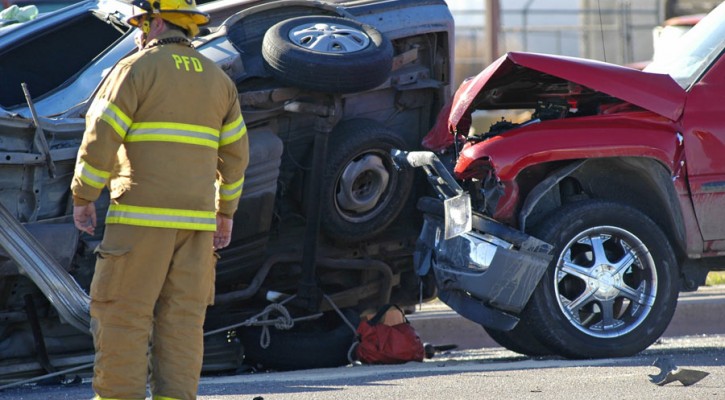Category Archive: Parents

Preventing Teen Vehicular Crashes
October 10, 2007
Geico, the automobile insurance giant, is not just known for their cute gecko or grunting cavemen commercial shtick. They also produce some great informational tools about your insurance and safe driving tips. There is an informational sheet Geico produced about the Top Ten Tips for preventing teenage crashes.
Really, the information is nothing new to anyone but it pays to be repetitive right? Teens probably only really absorb a quarter of what they hear and read when it is not a subject matter they really want to hear about like cleaning their room or *gasp* how to drive responsibly. Perhaps some parents should use the tip handout and tell their teens there will be a pop quiz on it later! Maybe then they will actually read it.
Anyway… there are some tips on there that are not really emphasized on other responsible teen driving diatribes. For instance, one of the tips is keeping it slow and steady and gradually build up to speedier driving venues. What this means is do not start driving lessons with your teen on the major highways that mimic the infamous Autobahn. Instead ease their way into those roads by practicing on driving within small towns or country roads. Practicing those speedy highways during down times is also beneficial. As the teen (and you as the parent) feel more confident about venturing on the highways in the height of craziness, then you can do so.
Another tip that doesn’t get as much play in the teen driving world is training to drive in poor conditions. Many parents are more apt to keep their teens from driving in the rain, snow or other weather conditions. This means, of course, that your teen will have no experience whatsoever in them. The best thing you can do (even though you won’t want to) is to take them out driving, at least in low populated or slow areas, during these conditions. If anything, drive around in the inclement weather in large parking lots, practicing turns and such for the experience. There are less things to hit in an empty parking lot!
Driving a safe vehicle is another safe teen driving tip and one that many people take for granted. Usually, the teen car is either the family car or a hand-me-down. On occasion, a new car or a used model may be purchased. Whatever you choose for your teen to tool around in, you must be sure that it is safe to drive. In this safe teen driving tip, you are the one that holds the ultimate power.
Parent-Teen Involvement Essential to the Drive Rite Keys to Smart Driving Program
August 23, 2007
There is a program in the Indianapolis area called the Drive Rite Keys to Smart Driving and it is being offered through the county sheriff’s office. This program is unique as it is a requirement for parents to monitor this course with their teenagers. What a novel idea – having parents take charge of their children’s driving! Instead of hoping that your teenager has gotten enough information through required driver’s education courses, this course is more comprehensive and takes six months to complete.
During the six-month course, teens learn responsible driving behavior, traffic safety, how to drive defensively, and how to handle an accident. Both parents and teens have to attend together and are taken through real world experiences as well as interactive lessons. Many parents feel that the course greatly enhances the regular curriculum they have studied through driver’s education.
The Drive Rite course also makes teenagers responsible for on-line assignments as well a driver’s logbook to write down all of their experiences while on the road. In addition, parents are required to monitor additional training outside the classroom behind the wheel of a car. With both parent and teen participation in this course, there should be no gray areas of understanding what a responsible driver really means. In fact, parents may get a few eye-openers as well. It never hurts to remind seasoned drivers of some of the safety rules because we all know that we can also be rather lax in driving habits!
The driving course is coordinated through Purdue University and while intense, only meets once a month for the six months. While the purpose of this class is to educate, it also does so much more. It gets both the parents and the teens talking to each other and relating how the other feels about driving, road responsibility and more. Even if either party doesn’t learn anything else, the Drive Rite class gets the parents and teens communicating which is sometimes half the battle.
The goal of the course is to help prevent teen deaths due to car accidents. Will this program work? Chances are that it will… at least for a while. With teens, those good habits have to be instilled early in order for them to stick whether they have others to distract them or not. Hopefully, with both the parents and the teens working together, the commitment to drive safely will stick far beyond the classroom walls.
Learn more about driver training and traffic school at Lowest Price Traffic School.
Behind the Wheel with the Tire Rack Street Survival Class
August 20, 2007
It seems that every state in the country is adopting or introducing new extracurricular driver’s education classes for teens. The death toll for teenage drivers is rather high across the country so classes such as the Tire Rack Street Survival are created to address the issue. Do these classes work or are they just another way for some company to make some money? How effective are these classes really?
While many classes like the Tire Rack Street Survival definitely educate young drivers, it is only through constant parental involvement that significant strides can be made in reducing the teenage driver death toll. Of course, these classes may work if more parents made their teens take them! Without the requirement of mandatory classes, not many teens are going to say, on their own, “oh I cannot drive as well as I should, maybe I should take a driver’s education safety class.” The only way that these classes will make a huge impact on dropping the teenage death tool is mandatory extracurricular driving classes like the Tire Rack Street Survival.
The Tire Rack class does more than just get parents a discount on their liability insurance. This class also teaches by example – behind the wheel of a car as well as the classroom. The material that is covered is real hands-on and you get to experience real world driving situations behind the wheel of your own car. It’s a great way to prepare teenagers about accidents and how to easily avoid them. Plus there is no need to adapt to a strange car either. Other advanced driving schools use simulated demonstrations or even a company car equipped to produce certain driving situations.
This class shows teenage drivers in real world time the consequences of their actions behind the wheel. They learn that every action, no matter how small, creates another action and so forth. So teens learn that split second they took to turn on the radio could be all that stands between them and a tombstone. These lessons that are learned should be ones that every teenager with a driver’s permit should have to receive. Unfortunately, this is not the case at all. Therein lies the problem.
In too many states, driver’s education has to be taken as an extra-curricular activity. So many times, teens do not even take a class and instead just study for and pass the written portion of the exam. Sure, their driving is evaluated but it is usually in a controlled setting. However, if mandatory classes were modeled after the Tire Rack Street Survival course or others, the overall fate of teenage drivers would be more optimistic.

Teen Driving Privileges Linked to School Attendance
July 31, 2007
There’s a new state law in Illinois that is supposed to crack down on teen driving privileges. The gist of it all is basically that teens that are truant in school and cut classes or are expelled could have their driving permits suspended until they turn 18. Apparently, lawmakers want to provide incentive for kids to stay in school.
There is some debate as to whether this new law will work or not. Various versions of this law have been passed in other states but the verdict is still out as to how well it is working. Eighteen unexcused absences, expulsion or dropping out are three ways that teenagers can lose their driving permits in Illinois.
Skeptics wonder how much of an impact this can have on teenagers. If they are aware of this new law long before they are eligible for driving, perhaps it will make some impression on those new teens that are starving for a little independence that driving can bring. However, exactly how is this new law going to be relayed to the teenagers that could be affected by it now?
Are schools going to go out of their way to broadcast this change? Chances are they will claim that they do not have adequate resources. Plus, teenagers have to do something drastic in order to have their driving permits revoked. By the time cutting classes or expulsion are caught, it is almost too late to do anything about it anyway. And 18 unexcused absences are quite excessive. Wouldn’t it be more effective if the requirement were half that?
The bottom line is while the law has good intentions, the problems lies in reinforcing it. Schools are overextended already. How is that information about unexcused absences, truancy and expulsion going to be relayed to the powers that be? Who is planning to do all the following up? It could literally take several years before the law really catches on and the truancy problems start to decline.
In the meantime, you have teens who would likely continue to drive even with truancy problems at school. Their misdeeds could literally take months to catch up with them in the form of a revoked driving permit. And for some, they could age out before they reap any consequences. That is not much of a slap on the wrist is it? This new law is a bit hazy still on how everything is supposed to play out. It will just have to be a wait and see game.

Driving Simulation Course a Great Tool for Better Driving
July 24, 2007
There’s a new course called Tragedy Prevention whose sole goal is to educate drivers about the dangers of the road in the hopes that accidents could be prevented. This is an excellent tool for not just reckless adult drivers who need driver’s education training, but also for new teenage drivers who need to be acclimated to the ways for the road.
Book learning in driver’s education can only take teens so far. Practical experience driving the roads definitely helps but they also need to experience potential dangerous situations so that they can anticipate their next moves and possible avoid a fatal accident. This Tragedy Prevention course is definitely a step in the right direction.
While this course is geared toward reckless drivers who may have had privileges suspended, there is also a special WHEELS program geared just for teens that is filling the driver’s education need since so many high schools are no longer offering the courses. What is so great is that teenagers are put through the paces in a simulator with different situations such as a tire blowout, driving at night or even dangerous weather conditions.
Typically, a teenager will not usually experience this in a real life training situation. However, at some point in their young life, these situations may happen. And without the proper guidance and anticipation of a solution, these teens could die in an accident. The purpose of Tragedy Prevention is to ensure that these teens understand the different dangers on the road and that sometimes, they themselves are the problem.
This training class shows teens through various simulations exactly what happens if they become distracted by cell phone texting or even if they drive under the influence. For many teens, it is quite an eye opener to be faced with their potential of mortality. And while most have admitted to driving and texting or drinking, many vow after the class that they will not do it again. That is great news for the teen participants of the class.
With some money and luck, perhaps other areas of the country will offer similar programs. Only with ready access in each and every state can this class work for teens. So, if you do not have any program such as Tragedy Prevention in your area, look and see what you can do to try and bring it to your area. Talk with legislators at the local and state levels and see what you all can do to pitch in together to keep our teens safe and educated about the hazards of the road.
